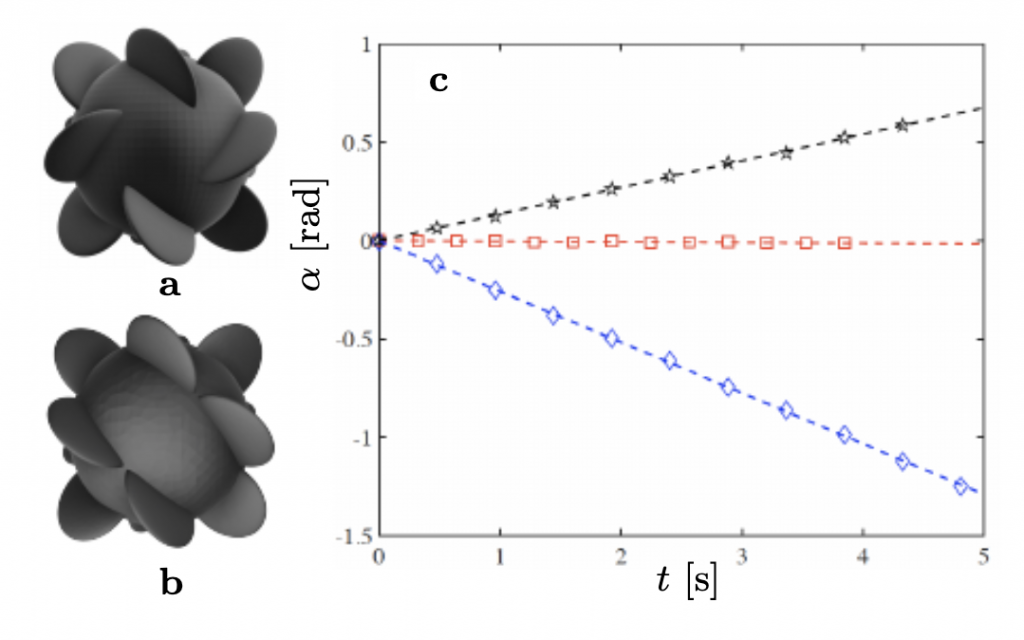Researchers at Wesleyan University have used 3D printing to reassess a long-standing theory proposed by British mathematician Lord Kelvin 150 years ago.
In essence, Kelvin predicted that a sphere shape with vanes known as an ‘isotropic helicoid’ would behave unusually if submersed in fluid, appearing to be the same from any angle while ‘naturally’ spinning. Until recently, the professor’s idea has been difficult to assess, but using a Form 2 3D printer the Wesleyan team has now produced an ultra-accurate sample, which may prove it needs revision after all.
“Our 3D printed implementation of his [Kelvin’s] design was found experimentally to have no detectable translation-rotation coupling, although the particle point-group symmetry allows for coupling,” said the team in their paper. “Kelvin’s predicted isotropic helicoid [therefore] exists, but only as a weak breaking of a symmetry of non-interacting vanes.”

Kelvin’s ‘isotropic helicoid’ theory
Back in 1871, Lord Kelvin, a pioneer best known for the temperature scale which bears his name, proposed that if created properly, isotropic helicoids would spin like a propeller when submerged in viscous fluid. In practise, such a shape would therefore be like a sphere, with the same drag regardless of its orientation, but also turn due to its in-built fins, some of which would be at 45° angles and others at 90°.
Theoretically, this helical behavior contradicts isotropic principles which support the idea of continuous rotational symmetry, but Kelvin always insisted that the shape’s fins counteract this effect. For their part, the Wesleyan team believe that the theory has been explored in text books for decades but they couldn’t find any evidence of new research, implying that prior studies were limited by available equipment.
“You’ve got to guess that somebody else has tried this in 150 years – in Kelvin’s original paper, it even sounds like he tried it,” Wesleyan University’s Greg Voth explained to New Scientist. “I suspect that people have tried to fabricate these particles, but they were limited by defects in the fabrication so they simply didn’t publish, so the hypothesis of this behaviour has stayed with us.”

Revising a 150-year-old thesis
In order to put Kelvin’s proposal to the test, the Wesleyan researchers decided to 3D print five slightly different isotropic helicoids, before dropping them into a tank of silicone oil. Interestingly, all five prototypes sank straight to the bottom of the tank, without exhibiting the expected ‘translation-rotation coupling’ spiralling motion, even though they had the same discrete symmetries as suggested by Kelvin.
To assess what went wrong, the team then conducted hydrodynamic analysis on their test setup, finding that the devices’ non-interacting vanes had caused their spinning effect to ‘vanish.’ While the scientists managed to identify a link between the movement and rotation of particles, proving this element of Kelvin’s theory correct, any coupling effects were actually too small to see with the naked eye.
“Our discovery of the small size of chiral coupling helps explain why there are no published measurements of isotropic helicoids.”
As a result, the researchers concluded that the force’s weak effect could be behind the lack of published research in this area, and that their study has provided “deep insights into quantum physics.” Moving forwards, the scientists say that “work to quantify and optimize isotropic helicoids may also be fruitful,” and they’re now considering how a reformed shape could help definitively prove Kelvin’s theory.
“We did not detect any translation-rotation coupling in our experiments. This raises the question of whether Lord Kelvin’s original argument is flawed,” concluded the team in their paper. “But taking into account hydrodynamic interactions between vanes, reveals non-zero translation-rotation coupling. The coupling is tiny, but it still exists.”
AM and the laws of physics
Surprisingly, the experiments carried out at Wesleyan University don’t represent the first time that 3D printing has been used to test well-established physics principles. Earlier this month, Youtuber ‘Integza’ 3D printed a replica wind-powered car that ‘breaks the laws of physics’ to help clarify the long-running ‘downwind faster than the wind’ or ‘DWFTTW’ debate.
The decade-long dispute dates back to 2010, when a wind-powered car was clocked by researchers as traveling down a runway nearly three times faster than the wind pushing it. While the host of the popular Veritasium Youtube channel Derek Muller maintained that this was indeed possible, the UCLA’s Professor Alex Kusenko disagreed, thus the pair wagered $10,000 that they could prove each other wrong.
Ultimately, with the help of fellow Youtuber Xyla Foxlin, Muller was able to make his case for DWFTTW sufficiently to win the bet, and Integza has since done the same. Using an Elegoo Mars Pro 2 3D printer, Integza has been able to produce a replica of the 2010 car’s design and deploy it on a treadmill, to show how the relative speed at which the wind hit its blades effectively enabled it to travel ‘faster than the wind.’
The Youtuber has kindly made his apparently physics-defying model available to download for free via Thingiverse.
The nominations for the 2021 3D Printing Industry Awards are now open. Who do you think should make the shortlists for this year’s show? Have your say now.
To stay up to date with the latest 3D printing news, don’t forget to subscribe to the 3D Printing Industry newsletter or follow us on Twitter or liking our page on Facebook.
For a deeper-dive into additive manufacturing, you can now subscribe to our Youtube channel, featuring discussion, de-briefs and shots of 3D printing in-action.
Are you looking for a job in the additive manufacturing industry? Visit 3D Printing Jobs for a selection of roles in the industry.
Featured image shows a 3D printed prototype of Lord Kelvin’s isotropic helicoid. Image via New Scientist.


